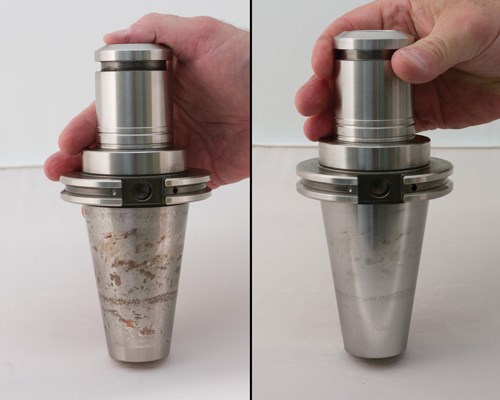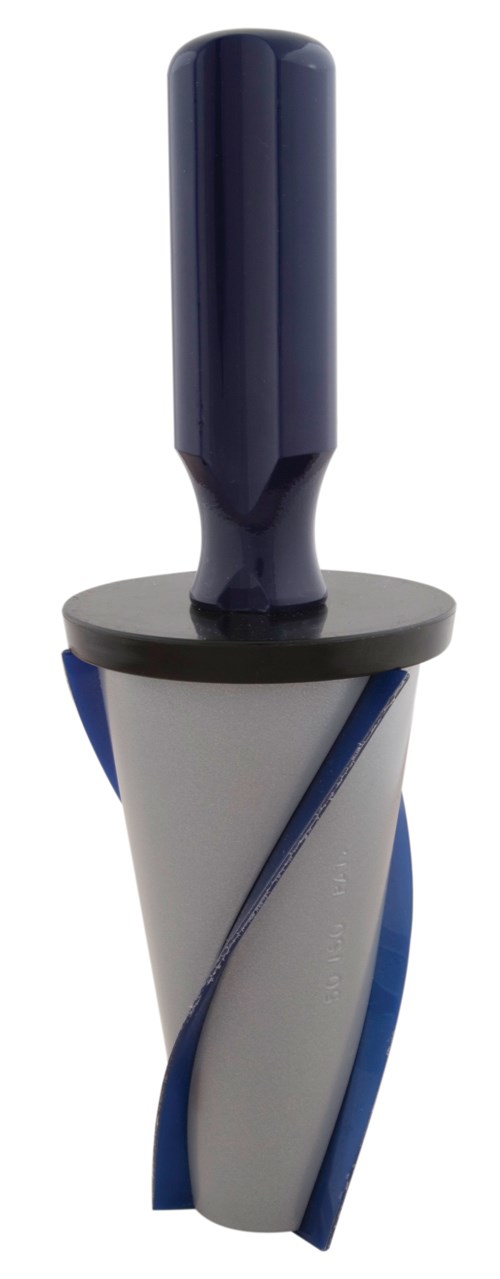8 Easy Tips for Spindle and Toolholder Hygiene
A minute chip floating in coolant swarf left to dry on a toolholder taper can eventually become a serious interference at the machine tool spindle-toolholder interface.
A minute chip floating in coolant swarf left to dry on a toolholder taper can eventually become a serious interference at the machine tool spindle-toolholder interface. This small chip can go undetected, causing slightly increased cutter runout (TIR) and diminished tool performance at low spindle speeds. However, at higher spindle speeds, the negative effects are magnified and can result in scrapped parts, catastrophic failure and a possible accident, which is why tooling manufacturers recommend regular cleaning and maintenance of toolholders, complete tooling system assemblies and machine tool spindles.
A contamination-free toolholder and machine tool spindle interface ensures toolholders properly seat at full taper contact and are pulled into the spindle taper at maximum force. With holders held and positioned accurately, a machine’s full power and tolerance capabilities can then effectively and safely transfer to cutting tools, while runout and vibration are reduced for superior part surface finish quality.
The following are eight simple tips for maintaining toolholder-machine spindle interface accuracy and integrity.
Shops should clean and inspect toolholders and spindles after every job. Toolholders should be completely disassembled and cleaned. Today’s synthetic and semi-synthetic coolants can leave surfaces gummy, causing chips and other contaminants to easily adhere to them. Machine spindles should be cleaned and visually inspected before being returned to service. An oil-dissolving cleaner can be used to clean any coolant residue from toolholder and spindle surfaces.
Dust-free cloths or paper towels with light penetrating oil and manual wiping tools work best for cleaning the spindle socket surface. Most manual wiping tools feature helical cleaning blades set at angles matching those of a machine tool’s spindle – CAT, BT, HSK and others. Once surfaces are cleaned, they should be sprayed with a coat of light penetrating oil to prevent rusting.
Shops should use a “ForceCheck” device to check their machine spindle’s pulling power on a quarterly basis. This practice should be employed as a preventive maintenance procedure, with results recorded and tracked. Any sudden drops in pulling force from one quarter to the next can indicate a potential issue with the spindle system and can provide early detection for preventing catastrophic failure.
If possible, a tool crib manager or designated tooling person should manage toolholder maintenance. As jobs are completed, and tools are returned to the crib, cutters and holders should be completely disassembled and all components cleaned manually or in an ultrasonic system, then reassembled. Ultrasonic cleaning systems quickly and efficiently clean toolholder tapers, collet cavities, holder nuts, collets and all the other smaller sub-assembly holder parts.
If toolholder tapers show visual signs of wear, manufacturers suggest running them through an automatic power-brush wiping system that uses rotating tapered brushes. After doing so, holders should be cleaned in an ultra-sonic cleaning system, wiped clean and sprayed with a coating of light penetrating oil.
Once spindles and toolholders have been cleaned, a visual inspection should be made of the surfaces. They should be free of any defects. If serious damage is found in a spindle interface surface, a professional may be needed to re-grind the spindle taper socket. Damaged toolholder or machine spindle surfaces left dirty or unrepaired will, in turn, damage other tool and machine spindle mating surfaces.
Obviously, once tooling has been cleaned and properly maintained, it should be stored so as to avoid any re-contamination as it moves from tool crib or tool cart to machine tools. Surface rust can occur while tools are stored, so they should always be sprayed with a coat of light penetrating oil. Shops should only load clean toolholders into machine spindles and automatic tool changing (ATC) systems. Again, dirty or damaged toolholder surfaces can easily transfer imperfections to other toolholders and onto machine spindle surfaces.
Implementing a consistent program of toolholder maintenance can pay large dividends over time. By making such procedures a routine on the shop floor, quality and safe operation become a given.
— REGO-FIX Tool Corporation
Related Content
Tool Path Improves Chip Management for Swiss-Type Lathes
This simple change to a Swiss-type turning machine’s tool path can dramatically improve its ability to manage chips.
Read MoreGerman Project Yields Three New Medical Machining Processes
Recent research has resulted in a new mix of high-speed turn whirl milling, polygon turning and rotational turning for manufacturing medical bone screws and out-of-round nails.
Read MoreAutomation Breakthroughs Revolutionize Precision Machining for Complex Parts
Marubeni Citizen-Cincom delivers custom solutions to address some of the biggest challenges in precision machining from handling small parts, to robot integration and unique tooling needs.
Read MoreThe Ins and Outs of Inserts
Understanding how inserts are made provides valuable insight into how their performance can be optimized.
Read MoreRead Next
A Tooling Workshop Worth a Visit
Marubeni Citizen-Cincom’s tooling and accessory workshop offers a chance to learn more about ancillary devices that can boost machining efficiency and capability.
Read MoreDo You Have Single Points of Failure?
Plans need to be in place before a catastrophic event occurs.
Read More5 Aspects of PMTS I Appreciate
The three-day edition of the 2025 Precision Machining Technology Show kicks off at the start of April. I’ll be there, and here are some reasons why.
Read More












.png;maxWidth=300;quality=90)











